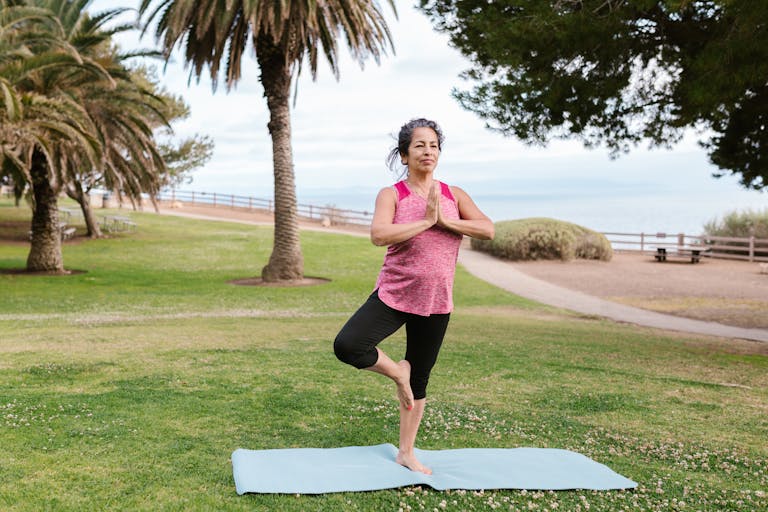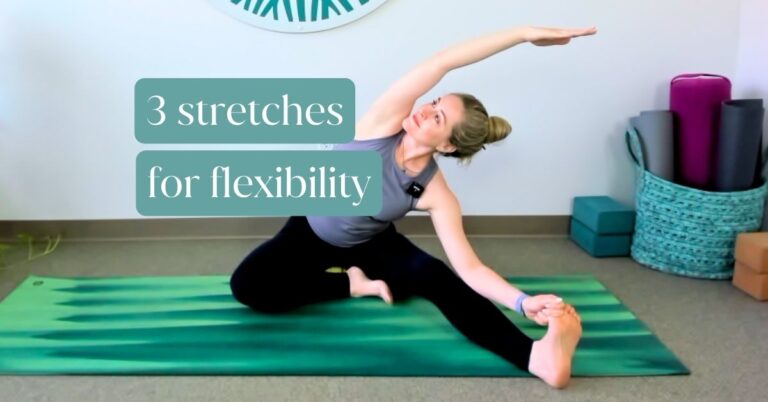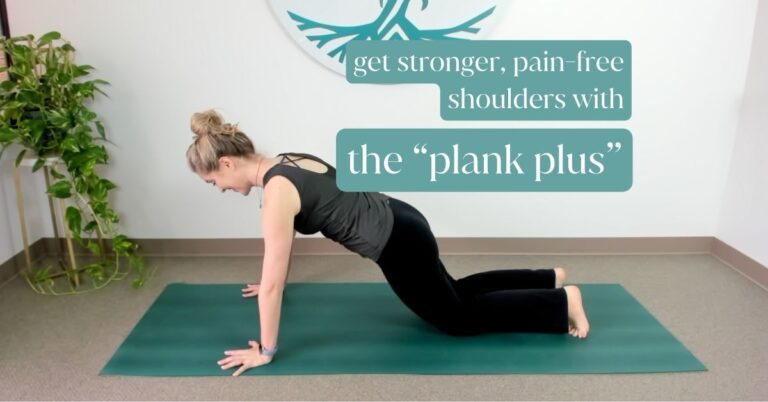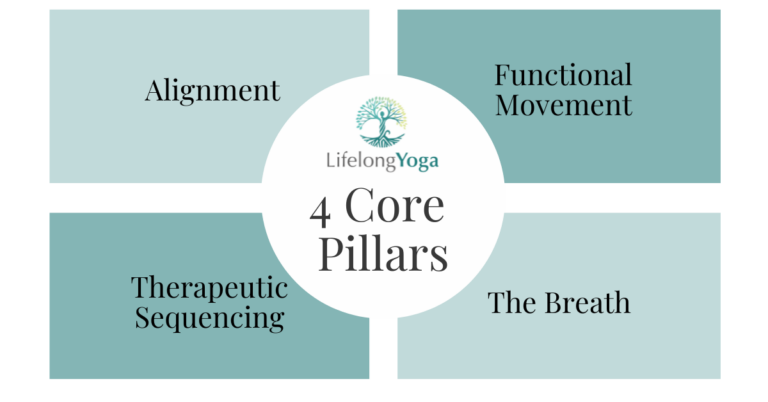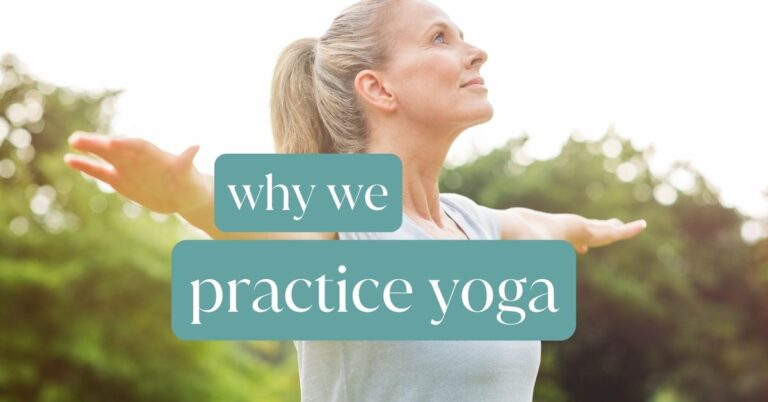Yoga for Balance and Fall Prevention
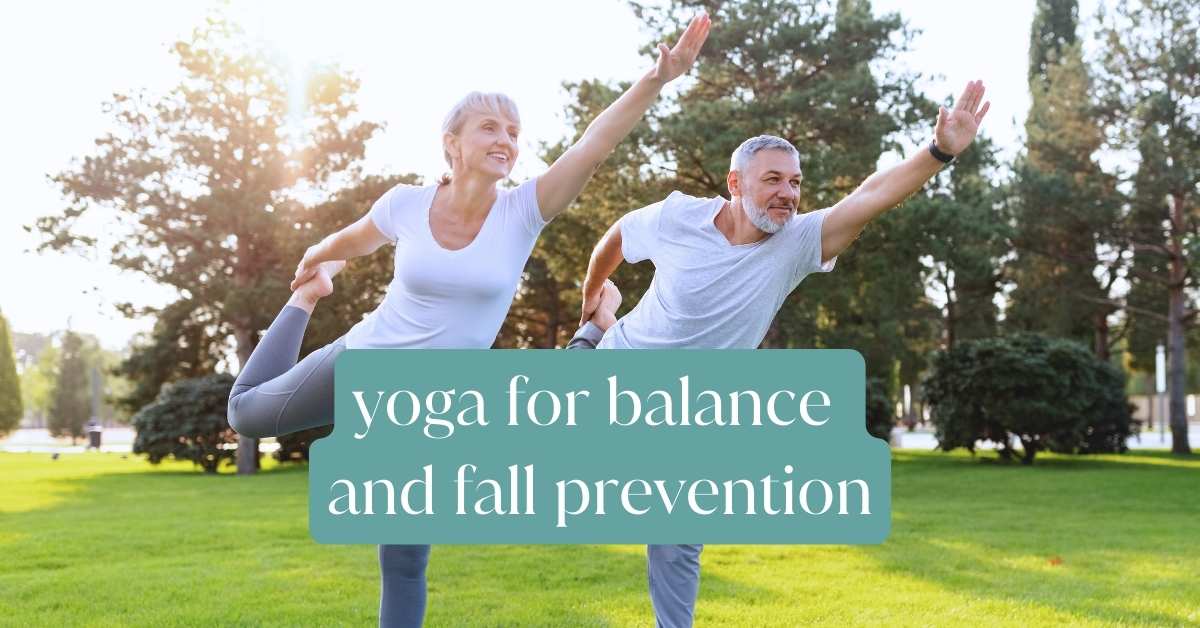
What is the most effective way to improve balance and prevent falls as we age?
As a yoga therapist and experienced yoga teacher specializing in healthy aging, I strongly believe that yoga is the best tool we have to prevent falls and keep ourselves steady on our feet.
Now, you might be wondering, “Yoga? Really?” I know it might not be the first thing that comes to mind when you think about fall prevention. But hear me out – there’s a good reason (or quite a FEW reasons, actually) why I’m so passionate about this topic!
In this blog, I’ll go into all the reasons WHY yoga is the best way to prevent falls and improve balance as we get older — and WHAT you can do specifically to get the most out of your practice with this goal of better balance in mind. Let’s jump right in!
The science speaks: Yoga is great for balance!
Did you know that one in four adults over 65 falls each year? That’s a startling statistic from the CDC.
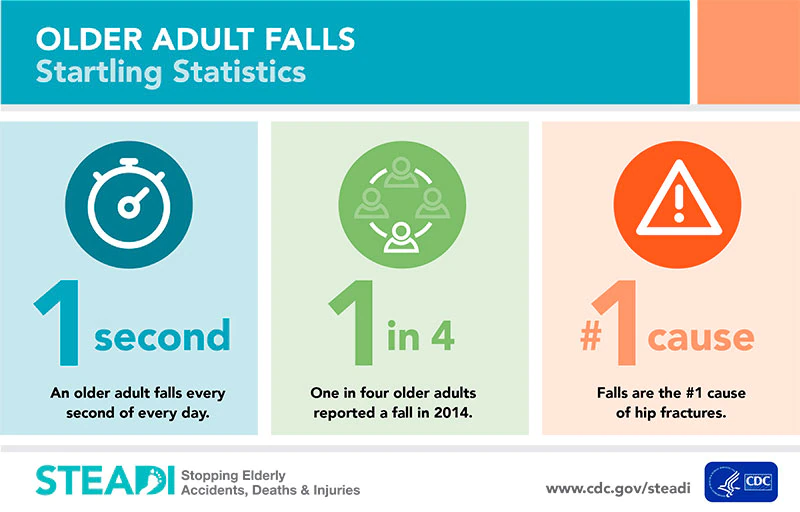
But here’s the good news: falls are preventable, and yoga can play a crucial role in keeping you balanced and confident. Research backs this up:
- A review of several studies showed that yoga programs for older adults, ranging from 4 to 12 weeks, consistently improved balance, mobility, gait speed, and reduced fear of falling. One study even found improvements in hip flexibility and stride length!
- This 2022 review found that regular yoga practice has a “beneficial effect on the quality of life and physical-functional capacity of older adults, thereby contributing to fall prevention.”
- A study in India found that after a 3-month yoga program, older adults showed significant improvements in two key areas: Physical performance and confidence! They could stand up from a chair much faster, indicating better leg strength and mobility, and they reported feeling less worried about falling in their daily lives.
What’s particularly exciting about these studies is that they show improvements in relatively short periods. You don’t have to practice yoga for years to see benefits. Even a few months of consistent practice can make a noticeable difference in your balance and stability.
How yoga improves balance: A holistic approach
To fully understand WHY and HOW yoga is so wonderful for improving balance, it’s important to first understand that yoga is not just about the poses. It’s a holistic practice that benefits your entire being.
Yoga is not just about the poses. It’s a holistic practice that benefits your entire being.
Mikah Horn
Yoga is unique in its ability to address multiple factors that contribute to falls – physical strength, mental focus, body awareness, and more. It’s a powerful tool for fall prevention.
Here’s how yoga works its magic on your balance:
1. Yoga builds strength and stability
Yoga is a fantastic way to build the strength needed for good balance. Many yoga poses act as gentle strength training, especially for your legs, glutes, and core – the key muscle groups that keep you steady.
When you hold poses like Warrior or Chair pose, you’re using your own body weight as resistance. This builds strength in a low-impact way that’s perfect for all ages and fitness levels.
As you practice regularly, you’ll find your legs becoming stronger and more stable. This increased strength gives you the power to maintain good posture and recover more easily if you start to lose balance. It’s like upgrading the engine that powers your stability!
Try this short yoga practice to get an idea of how yoga can progressively build physical strength: Gentle Yoga for Strong Legs!
2. Yoga improves mobility
Yoga helps maintain and improve your range of motion while reducing stiffness. This is important for navigating daily life with ease.
When you have a greater range of motion, your body can make adjustments if you start to lose your balance. It’s like having a wider safety net – you have more options to catch yourself and stay steady on your feet!
Take your ankles for example. They are particularly important for balance – they’re like the shock absorbers of your body! When you have good ankle mobility, you can adapt more easily to uneven surfaces or unexpected movements. Imagine walking on a slightly bumpy sidewalk. With mobile ankles, your feet can adjust to those little bumps and dips, keeping you stable. But if your ankles are stiff, even small changes in the ground can throw you off balance.

That’s why in yoga, we often focus on gentle ankle rotations and stretches. These movements help keep your ankles flexible and responsive, giving you a more solid foundation for all your daily activities.
3. Yoga develops body awareness
Have you ever wondered how you know where your arm is, even with your eyes closed? That’s proprioception in action!
Proprioception, or body awareness, is your body’s ability to sense where it is in space, and it’s one of the key systems involved in balance. (There are TWO other important balance systems, but I’ll save those for another blog post!)
The practice of yoga is like a master class in developing your body awareness. As you move through different poses, you’re constantly tuning into where your body parts are and how they’re moving. This heightened awareness doesn’t just stay on the yoga mat – it carries over into your daily life, helping you navigate your environment more safely.
For example, when you’re in Tree Pose, balancing on one leg, you’re not just building strength. You’re also developing a keen sense of how your foot connects with the ground, how your leg muscles engage to keep you steady, and how subtle shifts in your torso affect your balance.
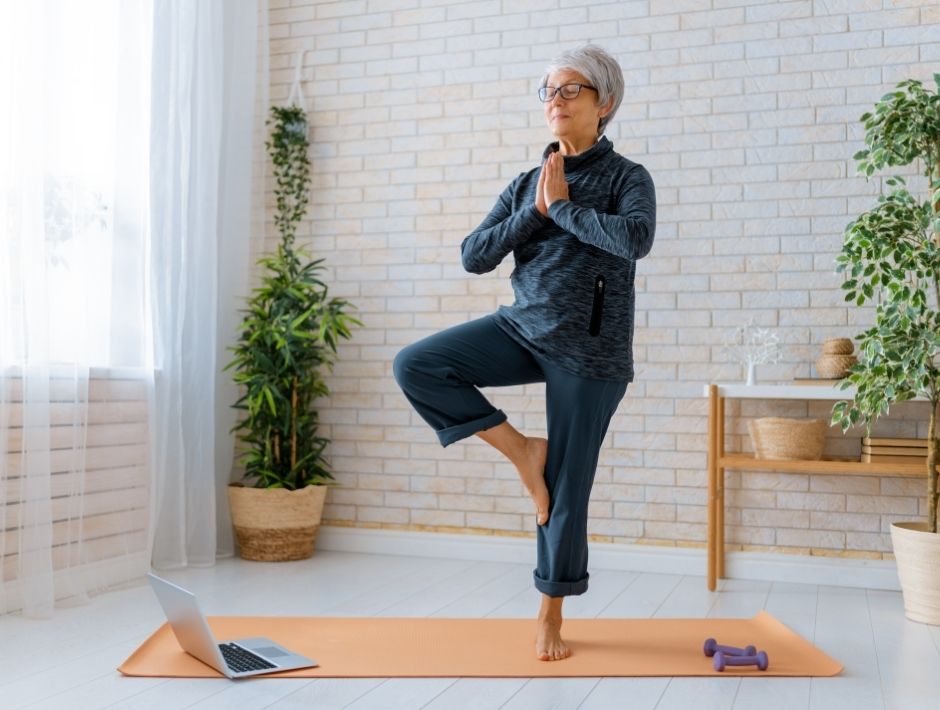
As you practice, you learn to notice small details about how your body feels and moves, making you more attuned to your body’s signals and better able to respond to them.
This improved body awareness means you’re more likely to catch yourself if you start to trip or lose balance in your day-to-day activities.
4. Yoga improves mindfulness and focus
Yoga trains your mind to stay present and focused. This mental clarity is essential when you’re moving through your day.
In yoga, we use several techniques to enhance focus and presence:
- Breath awareness: We practice keeping our attention on the breath, noticing its rhythm and sensation. This simple act of concentration carries over into daily life, helping you stay more present and aware of your surroundings.
- Drishti: In balance poses, we often use what’s called a ‘drishti’ or focused gaze. By fixing your eyes on a single point, you enhance your concentration and stability. It’s like creating an anchor for your balance!
- Body scanning: As we move through poses, we learn to pay attention to different parts of our body. This heightened body awareness helps you notice subtle shifts in your balance throughout the day.
These mindfulness practices have real-world benefits for balance and fall prevention. When you’re more focused and present, you’re better able to notice potential hazards in your environment. You’re also more likely to catch yourself if you start to lose balance, as you’re more tuned in to your body’s signals.
5. Yoga builds your confidence safely
One of the most powerful benefits I’ve seen in my students is increased confidence. Fear of falling can actually increase your risk of falls, creating a vicious cycle. Yoga breaks this cycle by building physical confidence.
But how exactly does yoga boost your confidence? It’s a gradual process that happens almost without you noticing. As you practice, you’ll find yourself becoming stronger and more stable. You’ll learn to trust your body more, knowing that you can maintain your balance in various positions.
Yoga also provides a safe environment to challenge yourself. In class, you might try a balance pose that feels a bit scary at first. But with the support of props, your teacher, and your fellow students, you can explore your limits safely. Each small success builds your confidence, both on and off the mat.
6. Yoga includes both static AND dynamic balance
One of yoga’s unique strengths in improving balance is its incorporation of both dynamic and static movements. This combination is necessary for developing comprehensive balance skills that translate to real-life situations.
Static balance poses, like Tree Pose or Mountain Pose, challenge you to maintain stability while holding still. These poses set up your foundation, and they also strengthen the small stabilizing muscles around your joints and improve your ability to make micro-adjustments to stay balanced.
Try this: Stand in Mountain Pose (feet hip-width apart, arms at your sides) near a wall or sturdy chair and close your eyes. Notice how your body subtly sways and adjusts to keep you upright. This is static balance in action!
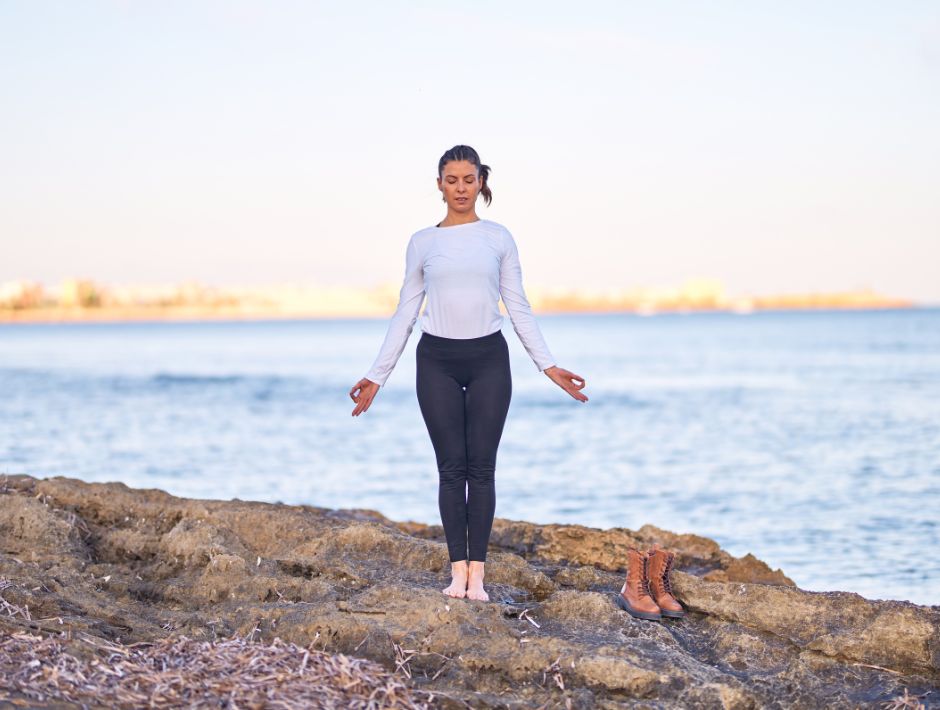
Dynamic balance, on the other hand, involves maintaining stability while moving. Flowing sequences that transition between standing poses challenges your balance in motion.
In life, when we experience a fall, we’re rarely standing still. This is why working on our dynamic balance is so important: Walking on uneven surfaces, quickly turning around, shifting our weight to avoid obstacles.
By practicing both dynamic AND static balance in yoga, we’re preparing our bodies for the full range of balance challenges we might encounter in everyday life.
By addressing all these aspects – physical strength, mobility, body awareness, mental focus, and confidence – yoga provides a comprehensive approach to improving balance.
A note on medical conditions
While yoga can be a powerful tool for improving balance and preventing falls, it’s important to remember that it’s not a cure-all. If you’re experiencing significant balance issues, particularly if they’ve come on suddenly or are accompanied by other symptoms, please consult with a healthcare professional.
Neurological, vestibular issues, or vision changes require specialized medical attention. If you’re experiencing balance problems and you’re not sure why, it’s always best to get checked out by your doctor or a specialist. Always consult with your healthcare provider before starting any new exercise program, including yoga.
Yoga and balance for every body
One of the things I love most about yoga is how it can be adapted for anyone. Whether you’re super active or you have limited mobility, there’s a yoga practice for you.
For those with arthritis, osteoporosis, pain, or chronic conditions, gentle yoga can be a game-changer. So if you’re looking to improve your balance without fast moving, high-impact movements that are hard on the joints, then look into gentle yoga.
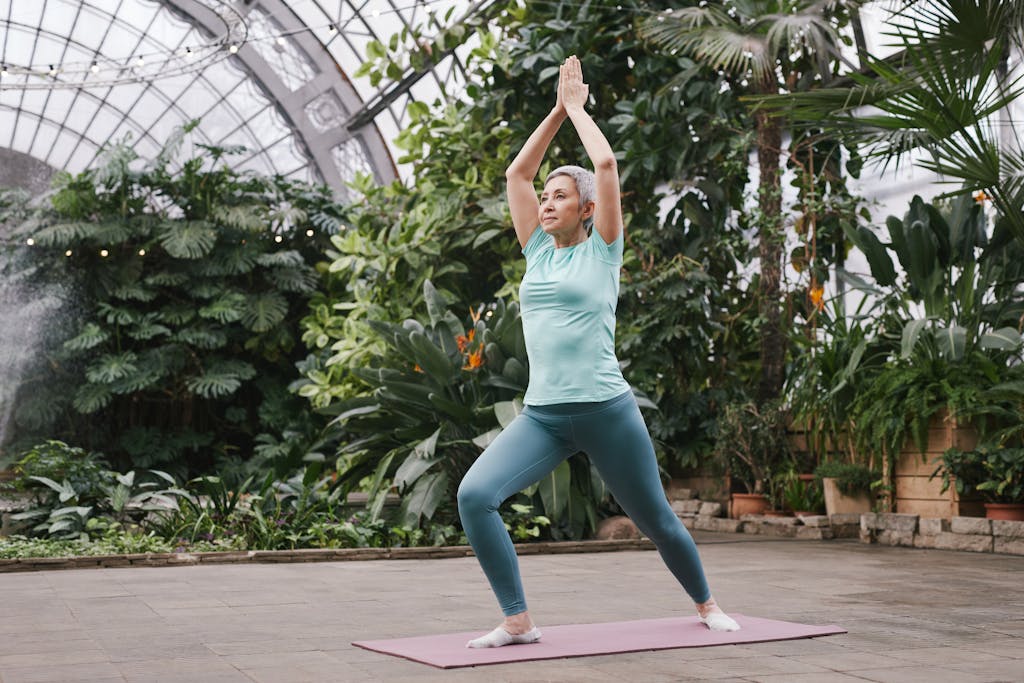
I teach a style of gentle yoga I call “Lifelong Yoga.” This is a form of yoga that’s specifically geared towards healthy aging and all that entails. I like to say: it’s gentle (and joint-friendly), but not easy! Lifelong Yoga WILL challenge you so you make progress in your practice, but we’ll do it in a way that feels good.
In Lifelong Yoga classes, we do get down on the floor (because I believe that’s one of the MOST important skills to work on as we get older), but we cushion our knees if needed, and we move slowly and take our time transitioning up and down.
We use props (yoga blocks, straps, blankets) to enhance body awareness, to make the practice more accessible, and to get the most benefits out of every posture.
We focus on functional movement, which is basically yoga to make your LIFE better. This is flexibility not just for flexibility’s sake, but so you can relieve tightness that’s restricting your daily activities. This is building strength to get up and down off the floor to play with your grandchildren with ease. This is joint mobility so your joints don’t ache in the morning when you first wake up.
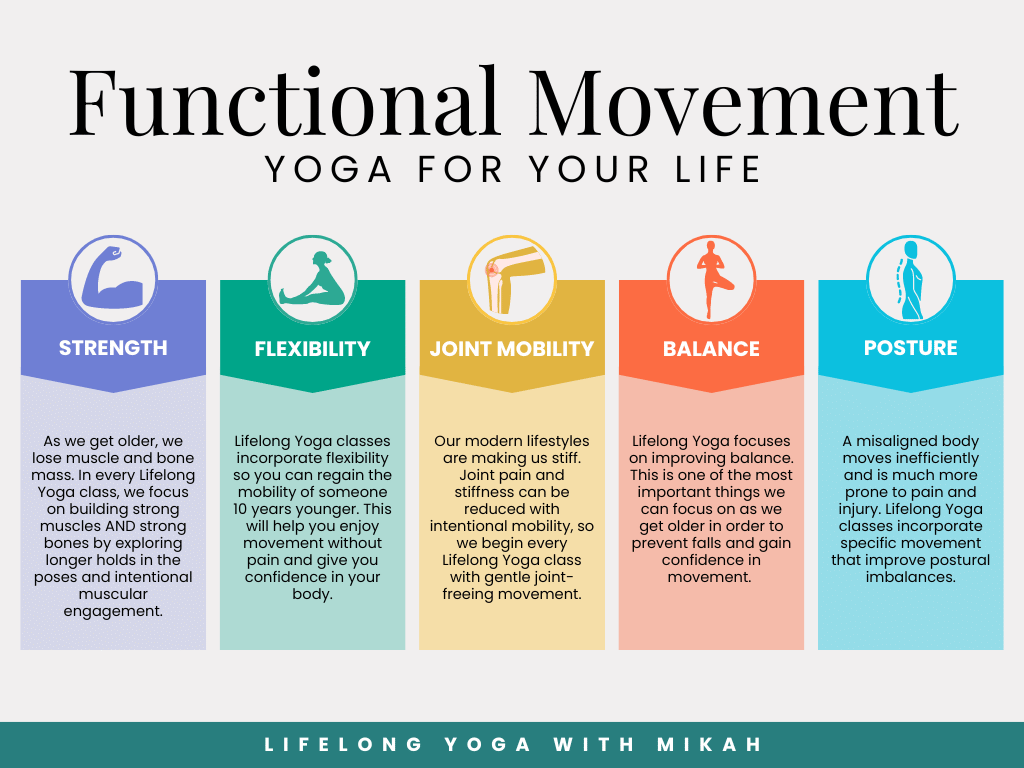
(If you want to learn more about the Lifelong Yoga method, read about our 4 Pillars for Healthy & Vibrant Aging.)
Remember, yoga is not about achieving perfect poses. It’s about working with your body, wherever it’s at today, and giving yourself grace along the way (as you gradually build body awareness, strength, flexibility, and balance).
Remember, yoga is not about achieving perfect poses. It’s about working with your body, wherever it’s at today, and giving yourself grace along the way.”
Mikah Horn
It’s never too early to start!
You know, I always tell my students that it’s never too early to start thinking about balance and fall prevention.
Take my student Angie, for example. At 57, she’s not what most people would consider a “senior,” but she’s got the right idea. Angie decided to be proactive about her own health after seeing her mom struggle with balance issues.
“Watching my mom’s challenges really opened my eyes,” Angie shared with me recently. “She has trouble going up stairs and even getting in and out of cars. She’s so worried about falling that she doesn’t even socialize or go out with friends anymore. I realized I don’t want that for my future.”
Angie’s story really hits home, doesn’t it? So many of us have loved ones facing similar challenges. But here’s the good news: by starting a yoga practice earlier in life, you’re building a foundation of strength and balance that will serve you well as you age.
Remember, we’re not just preventing falls – we’re building the strength and confidence to keep enjoying life to the fullest!
Frequently asked questions about yoga and balance
Q: I’ve never done yoga before. Is it too late to start?
A: It’s never too late to start yoga! Lifelong Yoga classes are designed for all levels, including complete beginners. We focus on gentle, accessible movement that can be modified to suit your body and your needs.
Q: Do I need to be flexible to do yoga for balance?
A: Not at all! Yoga helps improve flexibility over time, but you don’t need to be flexible to start. Lifelong Yoga’s balance-focused yoga practices emphasize strength, stability, and body awareness more than extreme flexibility.
Q: How often should I practice yoga to improve my balance?
A: Consistency is key. Even 10-15 minutes of practice 3-4 times a week can make a significant difference. The 5-Day Boost Your Balance challenge (coming up on September 23rd!) is a great way to start building a regular practice.
Q: Can I do yoga if I have joint problems or chronic pain?
A: Yes, yoga can be adapted for various health conditions. However, it’s important to consult with your healthcare provider before starting any new exercise program. In my Lifelong Yoga classes, I offer modifications and use props to make poses accessible and comfortable.
Q: Will yoga help me if I’m already active in other ways?
A: Absolutely! Yoga complements other forms of exercise by improving flexibility, balance, and body awareness. These benefits can enhance your performance and reduce the risk of injury in other activities.
Q: I’m worried about getting up and down from the floor. Do I have to do this in yoga?
A: While I do include floor work in my Lifelong Yoga classes (as it’s an important skill to maintain), I also offer modifications. You can use a chair for support if you’d like, and we take our time transitioning to and from the floor.
Q: How is yoga different from other balance exercises?
A: Yoga is unique because it combines physical movement with mindfulness and breath awareness. It not only improves physical balance but also enhances mental focus and body awareness, which are incredibly beneficial for preventing falls.
Your journey to better balance begins here!
Improving your balance is one of the best things you can do for your health and independence as you age. Yoga offers a gentle, effective, and enjoyable way to work on your balance, and I truly believe it’s the best tool for preventing falls and keeping you steady on your feet.
Remember, it’s never too late to start improving your balance. Whether you’re 50 or 80, whether you’ve never tried yoga or you’re returning after a break, there’s a place for you in this practice. Together, we’ll work on building strength, improving mobility, and boosting your confidence.
I can’t wait to see you on the mat!


